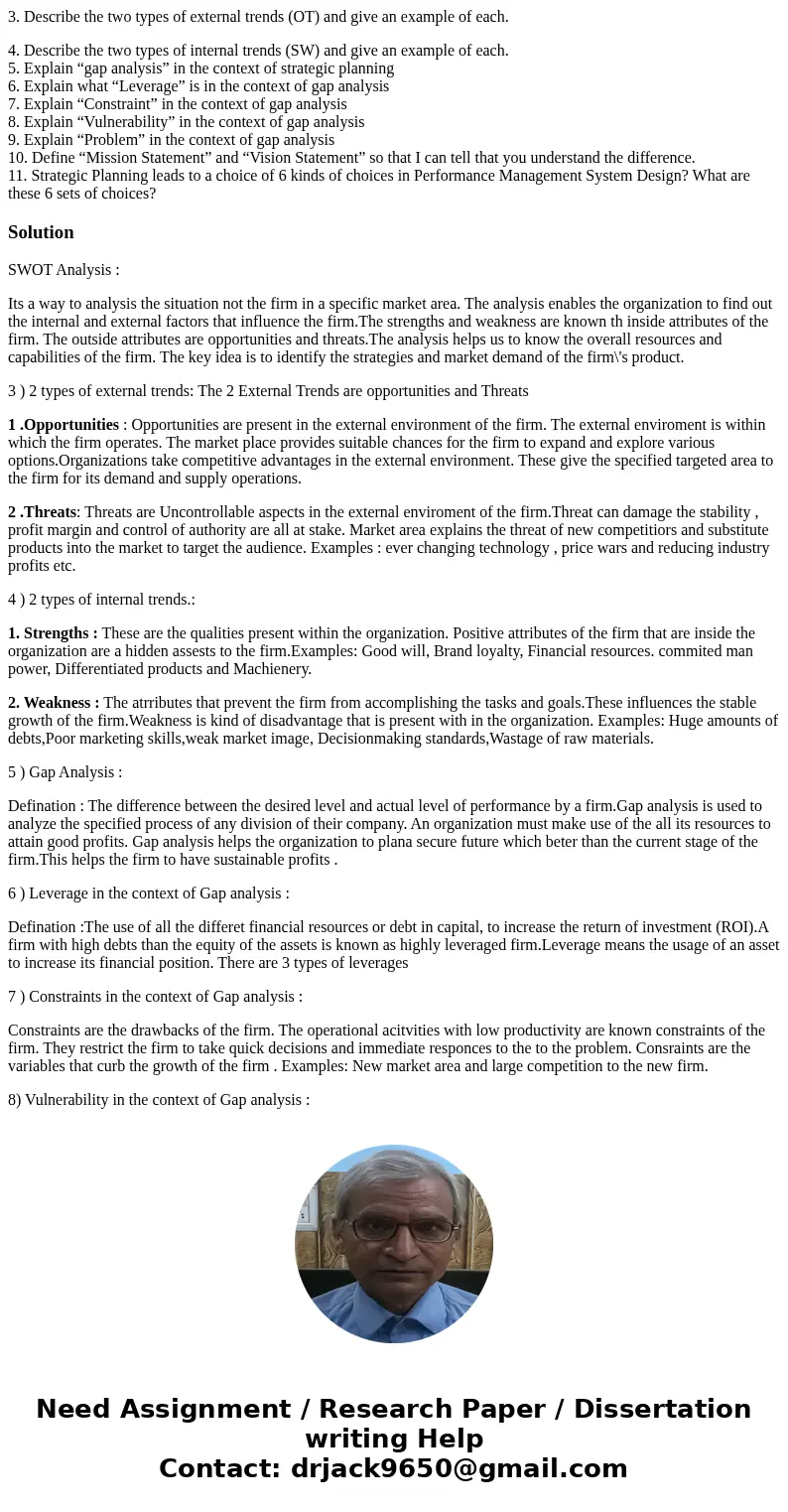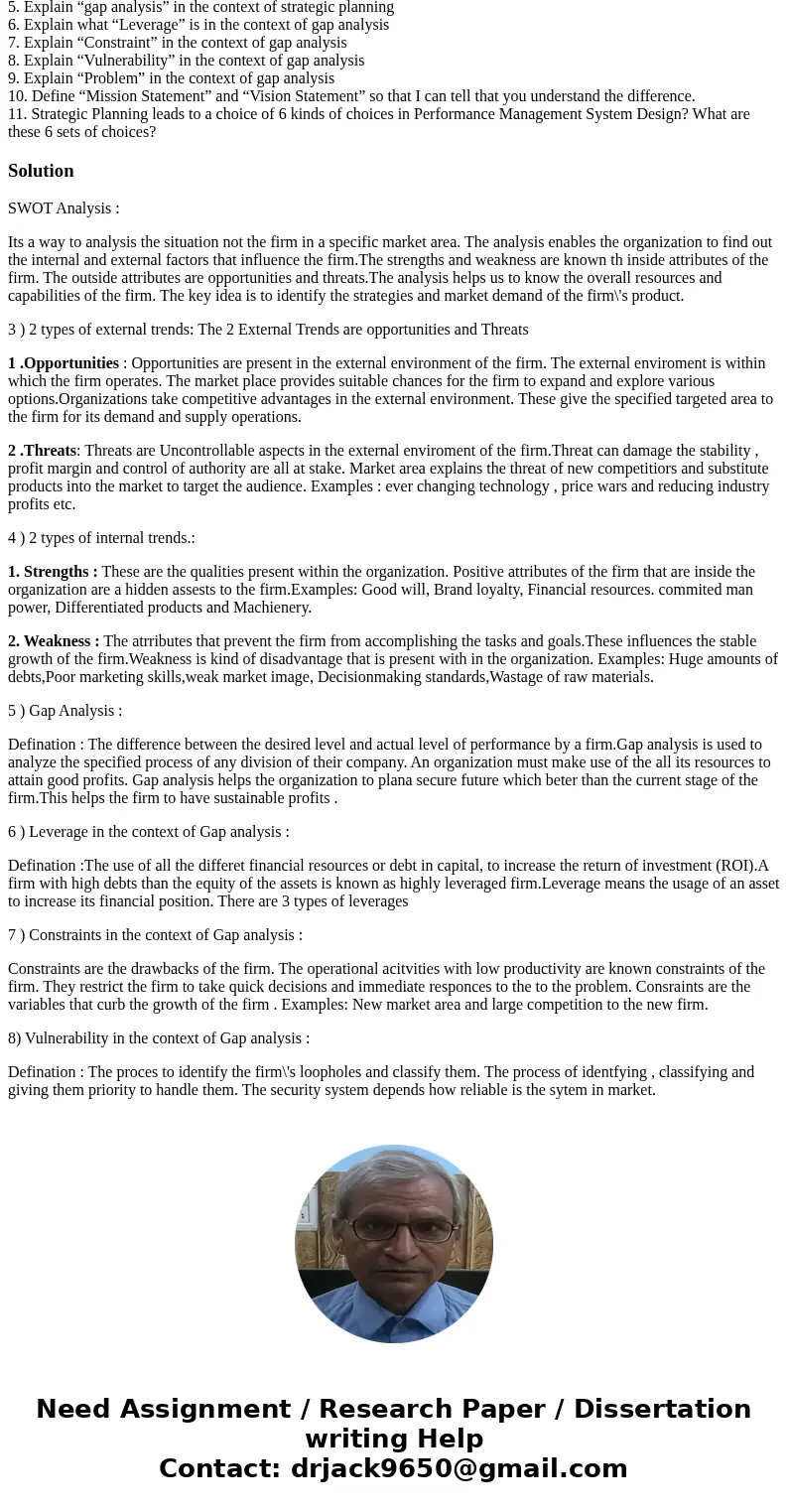3 Describe the two types of external trends OT and give an e
3. Describe the two types of external trends (OT) and give an example of each.
4. Describe the two types of internal trends (SW) and give an example of each.
5. Explain “gap analysis” in the context of strategic planning
6. Explain what “Leverage” is in the context of gap analysis
7. Explain “Constraint” in the context of gap analysis
8. Explain “Vulnerability” in the context of gap analysis
9. Explain “Problem” in the context of gap analysis
10. Define “Mission Statement” and “Vision Statement” so that I can tell that you understand the difference.
11. Strategic Planning leads to a choice of 6 kinds of choices in Performance Management System Design? What are these 6 sets of choices?
Solution
SWOT Analysis :
Its a way to analysis the situation not the firm in a specific market area. The analysis enables the organization to find out the internal and external factors that influence the firm.The strengths and weakness are known th inside attributes of the firm. The outside attributes are opportunities and threats.The analysis helps us to know the overall resources and capabilities of the firm. The key idea is to identify the strategies and market demand of the firm\'s product.
3 ) 2 types of external trends: The 2 External Trends are opportunities and Threats
1 .Opportunities : Opportunities are present in the external environment of the firm. The external enviroment is within which the firm operates. The market place provides suitable chances for the firm to expand and explore various options.Organizations take competitive advantages in the external environment. These give the specified targeted area to the firm for its demand and supply operations.
2 .Threats: Threats are Uncontrollable aspects in the external enviroment of the firm.Threat can damage the stability , profit margin and control of authority are all at stake. Market area explains the threat of new competitiors and substitute products into the market to target the audience. Examples : ever changing technology , price wars and reducing industry profits etc.
4 ) 2 types of internal trends.:
1. Strengths : These are the qualities present within the organization. Positive attributes of the firm that are inside the organization are a hidden assests to the firm.Examples: Good will, Brand loyalty, Financial resources. commited man power, Differentiated products and Machienery.
2. Weakness : The atrributes that prevent the firm from accomplishing the tasks and goals.These influences the stable growth of the firm.Weakness is kind of disadvantage that is present with in the organization. Examples: Huge amounts of debts,Poor marketing skills,weak market image, Decisionmaking standards,Wastage of raw materials.
5 ) Gap Analysis :
Defination : The difference between the desired level and actual level of performance by a firm.Gap analysis is used to analyze the specified process of any division of their company. An organization must make use of the all its resources to attain good profits. Gap analysis helps the organization to plana secure future which beter than the current stage of the firm.This helps the firm to have sustainable profits .
6 ) Leverage in the context of Gap analysis :
Defination :The use of all the differet financial resources or debt in capital, to increase the return of investment (ROI).A firm with high debts than the equity of the assets is known as highly leveraged firm.Leverage means the usage of an asset to increase its financial position. There are 3 types of leverages
7 ) Constraints in the context of Gap analysis :
Constraints are the drawbacks of the firm. The operational acitvities with low productivity are known constraints of the firm. They restrict the firm to take quick decisions and immediate responces to the to the problem. Consraints are the variables that curb the growth of the firm . Examples: New market area and large competition to the new firm.
8) Vulnerability in the context of Gap analysis :
Defination : The proces to identify the firm\'s loopholes and classify them. The process of identfying , classifying and giving them priority to handle them. The security system depends how reliable is the sytem in market.


 Homework Sourse
Homework Sourse